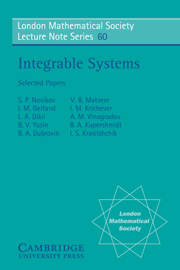Book contents
- Frontmatter
- Contents
- Introduction
- Asymptotic behaviour of the resolvent of Sturm-Liouville equations and the algebra of the Korteweg-de Vries equations (Volume 30, 1975)
- Proof of a variational relation between the coefficients of the asymptotic expansion of the resolvent of a Sturm-Liouville equation (Volume 33, 1978)
- Non-linear equations of Korteweg-de Vries type, finite-zone linear operators and abelian varieties (Volume 31, 1976)
- Methods of algebraic geometry in the theory of non-linear equations (Volume 32, 1977)
- Algebraic curves and non-linear difference equations (Volume 33, 1978)
- The structures of Hamiltonian mechanics (Volume 32, 1977)
- What is the Hamiltonian formalism? (Volume 30, 1975)
What is the Hamiltonian formalism? (Volume 30, 1975)
Published online by Cambridge University Press: 05 November 2009
- Frontmatter
- Contents
- Introduction
- Asymptotic behaviour of the resolvent of Sturm-Liouville equations and the algebra of the Korteweg-de Vries equations (Volume 30, 1975)
- Proof of a variational relation between the coefficients of the asymptotic expansion of the resolvent of a Sturm-Liouville equation (Volume 33, 1978)
- Non-linear equations of Korteweg-de Vries type, finite-zone linear operators and abelian varieties (Volume 31, 1976)
- Methods of algebraic geometry in the theory of non-linear equations (Volume 32, 1977)
- Algebraic curves and non-linear difference equations (Volume 33, 1978)
- The structures of Hamiltonian mechanics (Volume 32, 1977)
- What is the Hamiltonian formalism? (Volume 30, 1975)
Summary
In this paper the basic concepts of the classical Hamiltonian formalism are translated into algebraic language. We treat the Hamiltonian formalism as a constituent part of the general theory of linear differential operators on commutative rings with identity. We take particular care in motivating the concepts we introduce. As an illustration of the theory presented here, we examine the Hamiltonian formalism in Lie algebras. We conclude by presenting a version of the “orbit method” in the theory of representations of Lie groups, which is a natural corollary of our view of the Hamiltonian formalism.
“The present essay does not pretend to treat fully of this extensive subject, — a task which may require the labours of many years and many minds; but only to suggest the thought and propose the path to others.”
(From the introduction to “On a general method in dynamics” by W. R. Hamilton.)A curious fact that has come to light in the course of the last ten or fifteen years is the appearance of the Hamiltonian formalism of classical mechanics as an essential component of a number of mathematical theories, far removed from mechanics as such. Examples of this kind are the orbit method in the theory of representations of Lie groups (see [10] and [11]), the theory of local solubility of linear differential operators (see the survey [8]), the theory of a canonical operator (see [13] and [14]), and others.
- Type
- Chapter
- Information
- Integrable Systems , pp. 241 - 270Publisher: Cambridge University PressPrint publication year: 1981



